I'm no expert when it comes to painting and polishing, and everything i've learnt has come from TMF; but still I think what i've learnt from my experience doing my alloys and from TMF might be handy for someone else wanting to tackle a wheel refurb themselves.
So heres a list of stuff you might need for the job:
Paint stripper (I used nitromors)
Sandpaper - Various grades
Scotchbrite (optional)
Solvent wipes/Panel wipe
Etch Primer
Primer
Paint
Lacquer
Masking tape
Newspaper
If your wheels have a lip or dish you'd like to repolish, you'll also need:
Mains powered drill
Polishing Kit
Vienna lime powder (optional)
Autosol
Good quality protective wax
Here are the wheels which I started off with. 13x7" minilites, all had good tyres but were pretty badly corroded and so needed a refurb really:
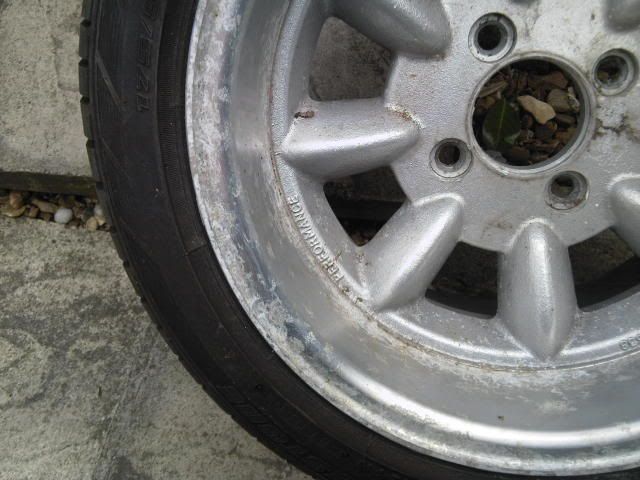
1. Stripping the old paint and lacquer off the wheels. Do this somewhere which won't be damaged by the paint stripper and minimise getting stripper on the tyres. i put mine in the wheel barrow as the tyres could be wedged against the side of it and kept the tyres out of all the stripper. Follow the instructions on the nitromors, and use an old brush to work more stripper in once the paint has bubbled. To remove the stripper/paint, scrape it off with a wall paper stripper or similar. I used a jet washer to blast all the paint and stripper off the rims where it wouldn't make a mess - Wear goggles if you do this:

When I'd done this, I actually put the wheels on the car and used it for a while before it was taken off the road for work to be done. Since they were bare, corrosion built up on the dishes of the wheels like so:
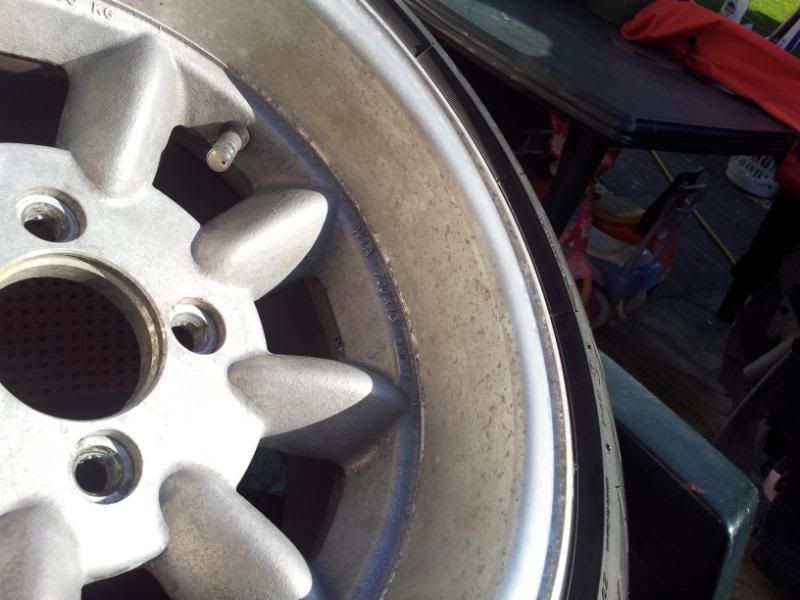
2. Corrosion also builds up under the lacquer, which is what actually gives the cloudy white look to polished wheels and cause's the lacquer to peel/flake. To remove this I found that some 400-600 grit wet&dry sandpaper worked well. Use it wet so the paper doesn't clog and this is a pretty quick process. Sand round the dish until you've removed the corrosion marks and any staining and got a nice smooth feeling dish. Shouldn't take more than 5-10 minutes a wheel. You'll end up with this:
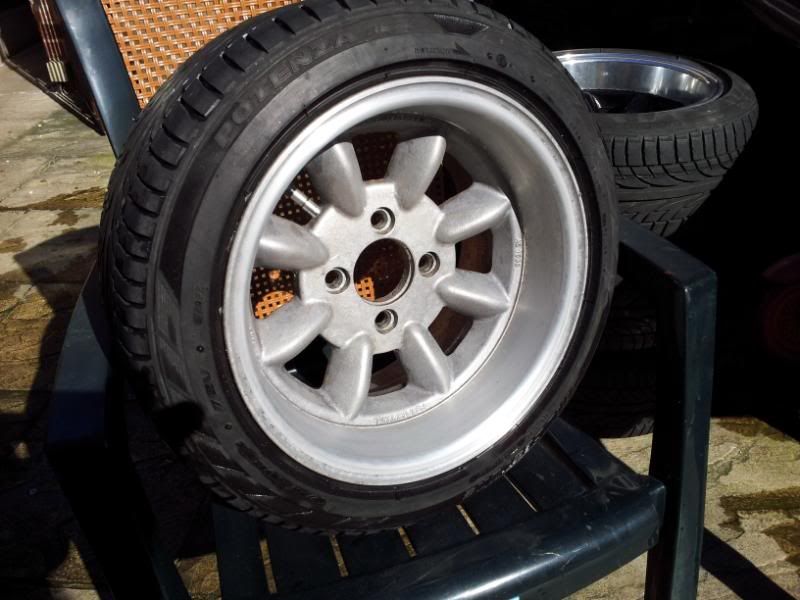
3. Curbing - If your wheels turn out to be badly damaged and curbed, repairs will be needed at this point. Its also going to prevent you from polishing the whole dish up, as polishing can only remove minor scratches and corrosion. if the curbing is only shallow, polishing will improve its appearance but if you wheels are badly curbed and have large chunks taken out of them, your only option is to fill these and paint the whole area.
My wheels had minor curbing on the very edge of the rim, which could be improved and still be polished and didn't require any filling. For minor curbing, use a fine file and file back the curbing and surrounding area. This will help level out rough curbing and remove any high spot's. After this you can sand the area like the rest of the dish and polishing will do the rest.
For deep curbing damage that requires filling, theres a couple of ways you can do this. Proper wheel refurb companies actually use welding to fill in curb damage which can then be ground back and reshaped and polished. This will be pricey, so realistically the only way to fill the damage is with normal body filler or with chemical metal or similar. I have seen curbing damage repaired with JB weld which once painted looks brand new. Just like when using filler on car bodywork, you just need to clean the area thoroughly, apply the filler and allow to cure. After which it can be sanded back and shaped, before paint.
4. Polishing- If your wheels are in good condition and you want to repolish the dish of the wheel, heres what you need to do. Get over to: http://www.thepolishingshop.co.uk/ and order yourself a budget metal polishing kit, and if you've got a few quid spare, get some vienna lime cleaning powder from there too. I only say this place as i've used them twice before and its good quality stuff, good price and quick cheap postage. In the kit you'll get 3 different grades of polishing mops, 3 blocks of polishing compound, an arbor to attach them to a drill and some little bob's to use in tight area's. You really need a main's powered drill for this, a battery drill just won't cut it.
First stage of polishing is with the harsh mop and black compound. Mount it on the drill, spin it up and hold the compound block against the mop for a few seconds. Don't be tempted to use too much polishing compound, it goes quite far. Once the mop contacts the dish of the wheel, you'll see the compound being transferred to it, but if you start seeing black greasy marks as you polish you are using way too much compound. The vienna lime powder is to remove compound when you've finished polishing, but you can use it to remove excess compound too if your getting the black marks. Just put a bit of it on a soft cloth and rub the excess compound off. Work your way around the dish with the harsh mop, a couple of passes with this mop and hard pressure should be sufficient. Using hard pressure, make sure you cover the whole dish and try to polishing in different directions by holding the drill at an angle to work across the scratches which will give you a finish like this:
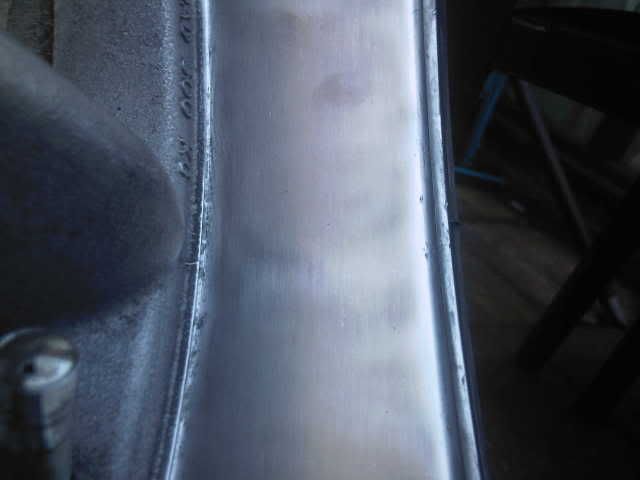
It begins to remove any remaining corrosion and sanding marks from the dish and begins to smooth out the metal. Do one or 2 more passes with the harsh mop using less pressure each time until you get a finish like this:
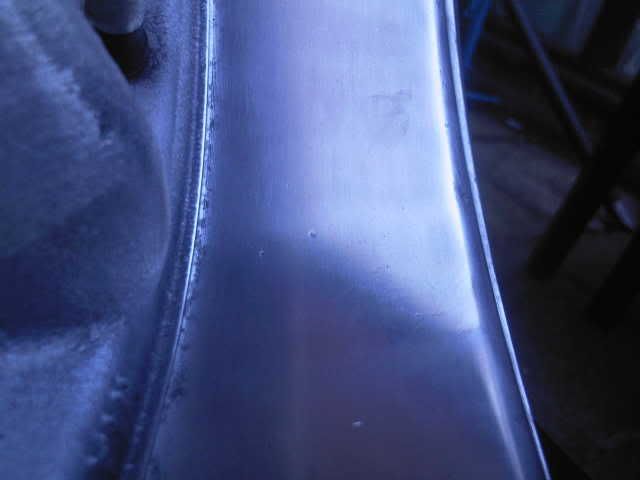
The surface should begin to shine and will feel smooth to the touch. You can use the small bobs to get at the areas the big mops won't reach, like the very inner edge of the dish.
Once your happy you've removed the sanding marks and smoothed the dish nicely, give the dish a rub round with the vienna lime again to remove any left over black compound before you move onto the next grade. The reason I list vienna lime as optional, is because you can also use solvent to remove excess compound, but it takes more work. The vienna lime really seems to grip the compound and wipes it off easy.
Next, attach the white stitched mop and spin some green compound onto it. Again, run this round the dish with medium pressure. This will begin to really shine up the previous finish and after a couple of passes will give you a better polished dish than what comes on most of the dishes when the wheels are brand new! Finish with this mop by giving it a final pass with light pressure (just the weight of the drill pretty much) and this will brighten it up nicely. Again, wipe any compound off with vienna lime before the next compound.
To complete the polishing, attach the loose cotton mop and use this with the blue compound. This is a finishing stage and shouldn't take long. it helps to remove any light polishing marks left from the previous steps and give a bright chrome finish. You only need to whizz this round the dish a couple of time under light pressure to see the results. You can go further than this with a lighter mop and compound also available from the same place the polishing kit comes from, but I was happy enough with the finish without these. Finish by giving the whole wheel (spokes too) a good wipe over with vienna lime to remove any left over compound, and go and have a shower as you will now be sporting a coal miner look, with compound all over you. I estimate I spent about 2 hours per wheel polishing to get this sort of finish:


Further info on polishing here: http://www.thepolish...hing_Guide.html
5. Paint prep - Next your ready to start getting ready for paint. The spokes on my wheels have quite a rough cast finish anyway so give quite good key to the paint. If your bare wheels are very smooth, chances are you will have polished the spokes slightly whilst polishing the dish. Give this is a rub over with wet&dry and remove any shine you've put on the spokes first. Then wash the wheel down with clean water and dry off. The next step is masking up the dish. If your not doing a polished dish on your rims, you just need to mask the tyre. I used wide masking tape round the dish, laid down right up to the edge of the spokes. Spend your time on this and you'll save yourself rubbing overspray off the dish later on. Then use a few sheet's of newspaper or similar, tape this to the dish and fold it over the tyre. Overlap the sheets and tape it down so no overspray hits the tyre.
When you've got them all masked up, use your solvent wipes to wipe any dust/grease from the wheel wherever your going to paint - Do not touch the surface after using the wipes or you'll contaminate it with the oil from your skin and you'll need to wipe it down again. Then your ready to etch primer the wheels. This is required for bare metal, as it eats into the metal and gives the primer a good key. You can get a big tin of it from halfords for around £8. A very thin layer of etch primer is all thats needed and it'll be dry and ready to be over sprayed in 45-60 mins. Obviously, spray in a well ventilated area and if you like, wear a filtered mask too.
Once thats touch dry, you can spray your first coat of primer. Most spray paints work best at room temperature, so if its cold, get a heater on or at least keep the spray cans in the house before use. Spray the primer from approx 6" away, as this prevents bits of paint drying before they hit the wheel which gives you a rough finish and make sure you get the whole wheel evenly covered. Primer coats can be sprayed 15 minutes apart (check the instructions on your particular paint) and ideally you want to get 2-3 coats of primer down. Allow the primer to become touch dry (around 2-3 hours depending on temperature) and then you need to spray a quick guide coat over it. The guide coat allows you to ensure you have rubbed down the whole wheel for the next stage and is worth doing, because if you fail to key some areas of primer before the paint goes on, its easy for the paint to chip off at a later stage - I learnt this the hard way. The guide coat is just a very quick mist layer of black paint over the primer - you could use other colours too as long as it shows up easily against the primer. Allow to dry overnight.
Next you need to rub down the primer before paint is applied. For this I used green scotchbrite pads off ebay, as they are a good grade for keying between coats. You can also wet sand the primer smooth, but this is harsher and easy to rub through the primer. Ensure you remove all the guide coat, that way you know you've keyed all the areas of primer before the paint is sprayed. When rubbed down, use solvent wipes again to remove any dust and grease left behind.
Here's my primered wheels after the guide coat had been rubbed back:

6. Paint & Lacquer - Now your ready to spray the wheels your chosen colour. Ensure the wheels are laid flat and level to prevent paint runs. Again, spray at room temp if you can or at least with the cans at room temp and apply the paint from approx 6" away for good coverage. The coats of paint can be applied 15 minutes apart and you want to try and get 3-4 coats on there. Once your happy with the coverage and coats you've got, leave the paint to flash off for 30-45 mins in a ventilated area.
Come back and inspect the wheels - Do not be tempted to touch the paint, you'll leave a finger print in the paint and will contaminate it with the oil from your skin. Check over the wheel looking for any runs, dust or reactions in the paint. If you do find you've got runs or dust has settled in the paint which your not happy with, you need to allow the paint to dry overnight then rub down the paint as you did with the primer to remove the imperfections and key the paint again. Then spray another coat of colour, again until your happy with the coverage and finish and allow to flash off again.
If your paint flashed off ok and stayed free of dust etc, your ready to spray the lacquer. The lacquer protects the paint and gives you a tough glossy finish. I personally find lacquer hardest to spray as it is very thin and obviously clear, so its easy to apply too much to one area and get runs. Keep the wheels flat to help prevent runs and spray the lacquer in short quick motions at a constant speed. Try not to spray the lacquer in a side to side motion, as when you slow your movement down whilst changing direction you'll spray too much in one area and risk it running. Again spray coats 15 minutes apart and try and get 3 coats on there. When you've got 3 coats on and your happy with the coverage and finish, leave the wheels to dry overnight at least before touching them again. It can take a week or 2 for the lacquer to harden fully, so you need to give it this time before attempting to polish the paint for example. You can tell when its fully dried when it no longer smells like paint - This is when all the solvents have dried off fully.


After leaving overnight (ideally a couple of days) you can then carefully remove your masking and inspect your results.

Repeat on all 4 wheels

7. Finishing off - You may find some paint managed to find its way under masking and onto the dish. If you look closely on mine you can see it did get under it in a couple of areas and about 2mm onto the dish.
To remove this, put a bit of thinners on a cloth and wipe with some pressure at the areas you want to remove. Don't touch the new paint with the rag though! If needs be, mask the spoke up a bit. If your struggling to remove it this way, you can try carefully removing it with a razor blade held at a very shallow angle to avoid scratching the dish.
You may also find that the paint primer has left a rough finish on the inside of the wheel where you didn't prep or spray, which is visible through the spokes and spoils the overall look of the wheels. To finish this off, I gave the inner wheel a quick rub down with scotchbrite, and brush painted a layer of hammerite on to finish it off:

Apart from that, a set of new centre caps and wheel nuts will finish the job off a treat
8. After-care - Some of you may question why the dish of the wheel is left unlacquered and bare. This is because the lacquer will not be able to 'grip' the polished surface and it won't last long at all. The lacquer will chip off very easily and once chipped corrosion of the dish will begin, and the lacquer will peel, leaving you back at square one with the dish to strip off and repolish - Just like what happens with the wheels in the first place.
To keep the dish protected, apply a few coats of good quality wax to the wheels. I used autoglym HD wax, but i'm aware theres also wax available specifically for rims which i'm keen to try out. The wax will protect the dish and prevent dirt and brake dust sticking, and make it easy to clean off. The wheels will need to be cleaned regularly to keep corrosion off the dish.
If corrosion does begin, it can simply be removed and the finish brought back using autosol on a cloth. Also, since the dish is left bare, you can remove the wheels, mask up the painted spokes and get the polishing kit out again and using only the stitched and loose mops, you can bring back the finish to a mirror shine in approx 20 mins per wheel.

















